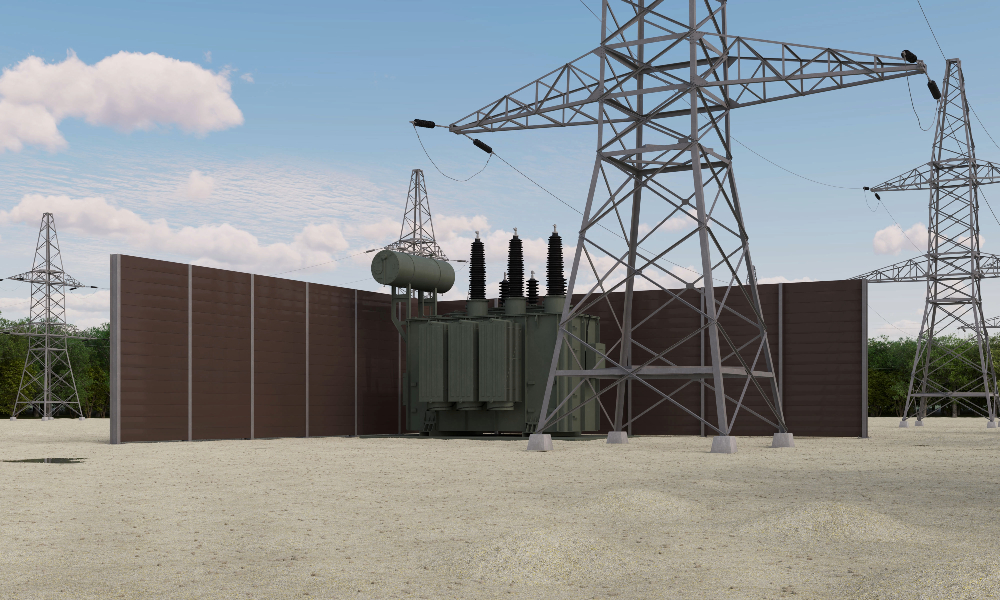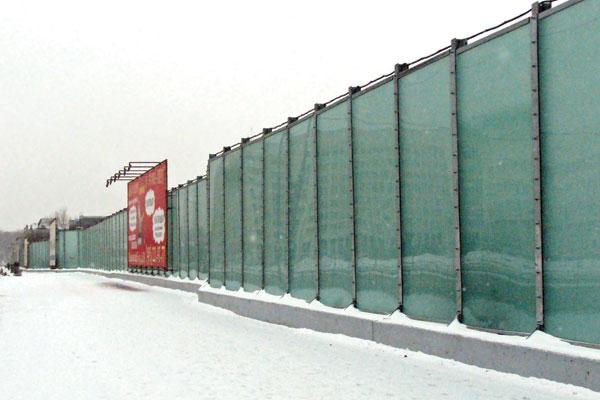Noise barriers have become a standard feature in many construction projects, aiming to shield nearby residents from the constant hum of machinery, transport, and other industrial activities. While these barriers are effective at reducing noise pollution, they may also disrupt local ecosystems in unexpected ways.
The impact of noise barriers on wildlife, plant life, and broader environmental dynamics is a growing concern among environmental scientists and urban planners.
Understanding Noise Barriers and Their Purpose
Noise barriers are physical structures made from dense materials like concrete, steel, or sound-dampening composites. They are designed to block or absorb sound waves, preventing noise from reaching nearby areas.
Construction projects near residential areas, schools, and natural reserves commonly employ these barriers to comply with noise ordinances and improve community relations.
The primary goals of noise barriers in construction are to:
- Reduce Noise Pollution: Noise barriers shield nearby areas from disruptive sound, contributing to a quieter environment.
- Minimise Health Risks: Chronic noise exposure is linked to health issues, such as stress, sleep disturbances, and cardiovascular problems. Noise barriers help reduce these risks for humans.
- Preserve Wildlife Habitats: In some areas, noise barriers aim to protect wildlife from construction-related noise, which can disrupt natural behaviours like hunting, nesting, and migration.
While these objectives are valuable, noise barriers can inadvertently interfere with natural processes in ways that may not be immediately apparent.
Potential Ecological Consequences of Noise Barriers
Disruption of Wildlife Communication and Movement
Many animals rely on sound for communication, navigation, and survival. Birds, amphibians, and mammals use vocalisations to communicate with mates, warn each other of danger, and coordinate group behaviours. When noise barriers block or alter sound waves, they can interfere with these natural communications. For instance:
Birds may have trouble finding mates if their calls are muffled or redirected by barriers.
Amphibians, such as frogs, depend on vocal signals during mating seasons, and noise barriers can disrupt these signals.
Migratory species may face navigation challenges, as noise barriers can create unfamiliar acoustic landscapes, confusing animals accustomed to certain auditory cues.
Additionally, some noise barriers are designed as solid, continuous structures, which can block wildlife movement pathways. Animals that previously travelled freely across the landscape may be forced to find alternative routes, increasing their risk of road accidents or leading to habitat fragmentation.
Altered Plant Pollination and Seed Dispersal
Noise barriers can affect pollinators, like bees and butterflies, that navigate partially through sound cues. Sound disruptions can confuse or repel certain pollinators, potentially reducing pollination rates in areas where noise barriers are installed. Reduced pollination can lead to diminished plant health, affecting biodiversity and food resources for other species.
Similarly, animals that contribute to seed dispersal, such as birds and small mammals, might avoid areas with noise barriers due to changes in sound dynamics or restricted movement. This can limit seed distribution in the area, potentially altering the natural composition and density of plant life over time.
Impact on Soil and Water Systems
Constructing noise barriers often requires ground disturbance, which can disrupt soil composition and water drainage. The installation of barriers may lead to soil compaction, erosion, or changes in natural water flow. In ecosystems where water flow is delicate, such as wetlands or marshlands, this can lead to unintended consequences, such as:
Altered moisture levels in the soil, affecting plant growth.
Reduced habitat quality for aquatic and semi-aquatic animals.
Greater risk of erosion during heavy rainfall, affecting nearby vegetation and creating sediment run-off into local waterways.
Even when noise barriers are strategically placed to minimise impact, the physical alterations to the landscape can still create long-term changes in local soil and water systems.
Increased Light Pollution
Noise barriers constructed in urban areas sometimes require lighting to ensure visibility and safety, especially along highways or near work sites. While this is beneficial for drivers and construction workers, it can lead to light pollution that disrupts local ecosystems.
Artificial lighting can interfere with nocturnal animals’ behaviours, disrupting their natural patterns of hunting, foraging, and migration. Increased light pollution can also impact plant growth cycles, particularly for species that rely on natural light cues for flowering or dormancy.
Changes in Predator-Prey Dynamics
In some cases, noise barriers alter the natural balance between predators and prey. For instance, birds of prey use sound cues to locate small mammals, while smaller animals rely on hearing to detect approaching predators.
Noise barriers that reflect or dampen sounds may unintentionally favour certain species over others, creating an imbalance in local food chains. Predators may find it harder to locate prey, while prey may be more vulnerable if they cannot detect predators due to altered acoustics.
Accumulation of Pollutants
Noise barriers along highways or industrial sites can trap pollutants such as dust, vehicle exhaust, and chemical particles on their surfaces. These pollutants may gradually accumulate, especially during rainy seasons, where run-off from barriers can carry contaminants into surrounding soils and water bodies.
Over time, the build-up of pollutants may impact plant health, reduce soil quality, and even affect water quality, posing risks to both terrestrial and aquatic ecosystems.
Steps to Minimise Ecological Impact of Noise Barriers
Given the potential ecological challenges, there are several ways construction projects can incorporate noise barriers while minimising harm to local ecosystems.
Use of Green Noise Barriers
Green noise barriers, also known as “living walls” or “green walls,” are designed to blend with the natural environment. These barriers are covered in vegetation, which can absorb sound, reduce dust, and provide habitats for insects, birds, and small mammals.
Green barriers also help regulate moisture, reduce soil erosion, and lower surface temperatures compared to traditional materials like concrete or steel.
Strategic Placement and Design
Thoughtful placement and design of noise barriers can minimise disruption to animal pathways and habitat connectivity. Considering local wildlife corridors and migration routes, construction projects can avoid creating physical obstructions that force animals into unfamiliar or hazardous areas. Creating gaps or using semi-permeable materials in areas with high wildlife traffic may help maintain natural movement patterns.
Avoiding Continuous Reflective Surfaces
Opting for sound-absorptive materials over reflective ones can prevent noise from bouncing back into the environment. Absorptive barriers help dampen sound without creating unwanted reflections that might disrupt nearby habitats. Additionally, using materials that blend visually with the surrounding environment may make noise barriers less intrusive for both humans and wildlife.
Erosion Control and Sustainable Construction Practices
To mitigate soil and water disturbances, projects can employ erosion control techniques, such as planting vegetation around barriers, using erosion control mats, or creating drainage systems that divert water away from sensitive ecosystems. Sustainable construction practices, including minimising ground disturbance and avoiding excess soil compaction, can help reduce the ecological footprint of noise barriers.
Incorporating Wildlife Crossings and Vegetated Buffer Zones
Adding wildlife crossings near noise barriers can provide safe pathways for animals, helping maintain habitat connectivity. Buffer zones with native vegetation can serve as a transition area between the construction site and the natural habitat, providing additional shelter, food sources, and reducing the impact of noise and pollutants on local ecosystems.
Regular Maintenance and Pollution Control
Noise barrier construction needs regular maintenance to remove accumulated pollutants and repair any damage that could lead to soil or water contamination. Conducting routine inspections and cleaning can help prevent harmful substances from affecting surrounding ecosystems.
A Balanced Approach to Noise Mitigation
While noise barriers offer a valuable way to reduce noise pollution, they can have unintended impacts on local ecosystems if not carefully managed. Taking a balanced approach—one that incorporates green design principles, strategic placement, and sustainable materials—can help minimise these impacts and create a more harmonious coexistence between construction projects and the natural world.
In the end, noise barriers are just one tool in the broader goal of noise management. Combining barriers with other noise mitigation strategies, such as quieter machinery, careful urban planning, and community engagement, construction projects can contribute to a quieter environment without compromising ecological integrity.





